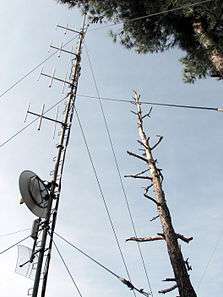Collinear antenna array



In telecommunications, a collinear antenna array is an array of dipole antennas mounted in such a manner that the corresponding elements of each antenna are parallel and collinear, that is they are located along a common line or axis.
Collinear arrays of dipoles are high gain omnidirectional antennas. A dipole has an omnidirectional radiation pattern when in free space and not influenced by any other conductors in that it radiates equal radio power in all azimuthal directions perpendicular to the antenna, with the signal strength dropping to zero on the antenna axis. The purpose of stacking multiple dipoles in a vertical collinear array is to increase the power radiated in horizontal directions and reduce the power radiated into the sky or down toward the earth, where it is wasted. They radiate vertically polarized radio waves. Theoretically, when stacking idealised lossless dipole antennas in such a fashion, doubling their number will produce double the gain, with an increase of 3.01 dB. In practice, the gain realized will be below this due to imperfect radiation spread and losses.
Collinear dipole arrays are often used as the antennas for base stations for land mobile radio systems that communicate with mobile two-way radios in vehicles, such as police, fire, ambulance, and taxi dispatchers. They are also sometimes used for broadcasting.
Multiple directional antennas mounted vertically separated are referred to as "stacked" and if alongside each other as "bayed".
References
![]() This article incorporates public domain material from the General Services Administration document "Federal Standard 1037C".
This article incorporates public domain material from the General Services Administration document "Federal Standard 1037C".